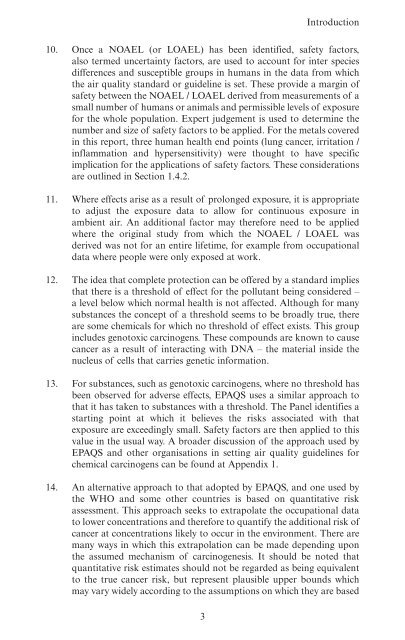Guidelines for Metals and Metalloids in Ambient ... - ARCHIVE: Defra
Guidelines for Metals and Metalloids in Ambient ... - ARCHIVE: Defra
Guidelines for Metals and Metalloids in Ambient ... - ARCHIVE: Defra
Create successful ePaper yourself
Turn your PDF publications into a flip-book with our unique Google optimized e-Paper software.
Introduction<br />
10. Once a NOAEL (or LOAEL) has been identified, safety factors,<br />
also termed uncerta<strong>in</strong>ty factors, are used to account <strong>for</strong> <strong>in</strong>ter species<br />
differences <strong>and</strong> susceptible groups <strong>in</strong> humans <strong>in</strong> the data from which<br />
the air quality st<strong>and</strong>ard or guidel<strong>in</strong>e is set. These provide a marg<strong>in</strong> of<br />
safety between the NOAEL / LOAEL derived from measurements of a<br />
small number of humans or animals <strong>and</strong> permissible levels of exposure<br />
<strong>for</strong> the whole population. Expert judgement is used to determ<strong>in</strong>e the<br />
number <strong>and</strong> size of safety factors to be applied. For the metals covered<br />
<strong>in</strong> this report, three human health end po<strong>in</strong>ts (lung cancer, irritation /<br />
<strong>in</strong>flammation <strong>and</strong> hypersensitivity) were thought to have specific<br />
implication <strong>for</strong> the applications of safety factors. These considerations<br />
are outl<strong>in</strong>ed <strong>in</strong> Section 1.4.2.<br />
11. Where effects arise as a result of prolonged exposure, it is appropriate<br />
to adjust the exposure data to allow <strong>for</strong> cont<strong>in</strong>uous exposure <strong>in</strong><br />
ambient air. An additional factor may there<strong>for</strong>e need to be applied<br />
where the orig<strong>in</strong>al study from which the NOAEL / LOAEL was<br />
derived was not <strong>for</strong> an entire lifetime, <strong>for</strong> example from occupational<br />
data where people were only exposed at work.<br />
12. The idea that complete protection can be offered by a st<strong>and</strong>ard implies<br />
that there is a threshold of effect <strong>for</strong> the pollutant be<strong>in</strong>g considered –<br />
a level below which normal health is not affected. Although <strong>for</strong> many<br />
substances the concept of a threshold seems to be broadly true, there<br />
are some chemicals <strong>for</strong> which no threshold of effect exists. This group<br />
<strong>in</strong>cludes genotoxic carc<strong>in</strong>ogens. These compounds are known to cause<br />
cancer as a result of <strong>in</strong>teract<strong>in</strong>g with DNA – the material <strong>in</strong>side the<br />
nucleus of cells that carries genetic <strong>in</strong><strong>for</strong>mation.<br />
13. For substances, such as genotoxic carc<strong>in</strong>ogens, where no threshold has<br />
been observed <strong>for</strong> adverse effects, EPAQS uses a similar approach to<br />
that it has taken to substances with a threshold. The Panel identifies a<br />
start<strong>in</strong>g po<strong>in</strong>t at which it believes the risks associated with that<br />
exposure are exceed<strong>in</strong>gly small. Safety factors are then applied to this<br />
value <strong>in</strong> the usual way. A broader discussion of the approach used by<br />
EPAQS <strong>and</strong> other organisations <strong>in</strong> sett<strong>in</strong>g air quality guidel<strong>in</strong>es <strong>for</strong><br />
chemical carc<strong>in</strong>ogens can be found at Appendix 1.<br />
14. An alternative approach to that adopted by EPAQS, <strong>and</strong> one used by<br />
the WHO <strong>and</strong> some other countries is based on quantitative risk<br />
assessment. This approach seeks to extrapolate the occupational data<br />
to lower concentrations <strong>and</strong> there<strong>for</strong>e to quantify the additional risk of<br />
cancer at concentrations likely to occur <strong>in</strong> the environment. There are<br />
many ways <strong>in</strong> which this extrapolation can be made depend<strong>in</strong>g upon<br />
the assumed mechanism of carc<strong>in</strong>ogenesis. It should be noted that<br />
quantitative risk estimates should not be regarded as be<strong>in</strong>g equivalent<br />
to the true cancer risk, but represent plausible upper bounds which<br />
may vary widely accord<strong>in</strong>g to the assumptions on which they are based<br />
3
















